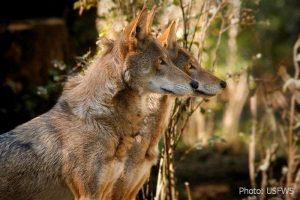
With less than 40 critically endangered Red wolves, they could go extinct within eight years, according to a report recently released by the U.S. Fish and Wildlife Service. It continues getting worse because now USFWS formally proposed a rule shrinking the management area for the North Carolina red wolf from the current range of nearly 2 million acres down to a single national wildlife refuge and an adjacent former bombing range. Many say this makes no sense! This signals the Trump administration’s total capitulation to a small group of ideological wolf opponents. The proposed rule shrinks the red wolf management area by 90 percent and removes any protections from wolves beyond the area’s boundaries, allowing killing on private land without repercussions.
The proposal guarantees the destruction of a population that was once on the rebound.
We have an opportunity to submit comments that began today, 6-28-18 https://www.regulations.gov/document?D=FWS_FRDOC_0001-1677
WASHINGTON POST
June 27 at 2:14 PM
In a proposal that would essentially end a 30-year effort to reestablish critically endangered American red wolves in North Carolina, the Interior Department on Wednesday announced a plan that would allow private landowners to kill wolves that stray onto their property from a protected federal wildlife refuge.
U.S. Fish and Wildlife officials who presented the proposal in a news conference said the Alligator River National Wildlife Refuge, which supports about a dozen of the 35 red wolves that roam a five-county area in eastern North Carolina, would be the only place where they would be safe.
The service’s new objective, said Leopoldo Miranda, assistant director for ecological services in the agency’s Southeast region, would be to intensively manage a small population of 10 to 15 red wolves at the refuge to preserve their genetic value and wild behaviors in the hopes that officials can find a location more friendly and suitable than eastern North Carolina.
Miranda declined to name areas that are in consideration to relocate the wolves. But he said that the process of identifying an area and securing an agreement to introduce wolves would probably take three years.
“Success for me right now is to keep this smaller wild population as intact as possible,” Miranda said. It will take hard work, outreach with state officials and conservation groups dedicated to saving red wolves, and research that can guide government officials to more supportive habitat.
North Carolina game officials have openly opposed the presence of red wolves in their state, and conservationists have said Interior’s management of red wolves in recent years betrayed the mission to preserve them. The new proposal fueled the anger.
A public meeting is set for July 10 in Manteo, N.C., and the public commentperiod starts today, Thursday6-28-18 and will conclude at the end of next month.
If the proposal goes into effect in November, as officials propose, up to two dozen red wolves outside the refuge would be left to survive on their own or potentially be legally shot by property owners who have long been hostile to their presence.
Like all wolves, red wolves are predators of mostly small game, and they naturally stray from boundaries drawn by humans. Before a federal court stopped the Fish and Wildlife Service from issuing permits to shoot wolvestwo years ago, the agency received at least 400 requests from landowners to kill them.
Miranda acknowledged that no red wolves can be killed with a court injunction in place and suggested that a final decision hinged in part on Fish and Wildlife’s proposal. But Ramona McGee, a staff attorney for the Southern Environmental Law Center, which filed the lawsuit that triggered the injunction, disagreed.
“The court has all the information it needs,” McGee said. She called the service’s recent management of red wolves “an egregious violation of the Endangered Species Act” and said the “injunction remains in place until the Fish and Wildlife Service goes to the court and asks to have it removed.”
“We’re very disappointed in this plan,” McGee said of the proposal. “It’s a plan that effectively dooms the red wolf in the wild. It’s not enough to sustain a population, and if they wander off that [refuge] they can be shot and killed the moment they cross that boundary.”
North Carolina is fighting coyotes through hunting permits. Red wolves are sometimes shot by hunters who said they confused them with coyotes. Landowners opposed to red wolves also complained that the wolves killed livestock and reduced game animals such as deer that people like to hunt.
But data released Tuesday disputed that, as Sutherland pointed out: “Ironically, despite all of the hatred spewed at the wolves, [Fish and Wildlife] indicates that only seven confirmed cases of livestock depredation, all small animals like chickens and goats, have occurred since 1987.”
Comments
This is so wrong!!!!